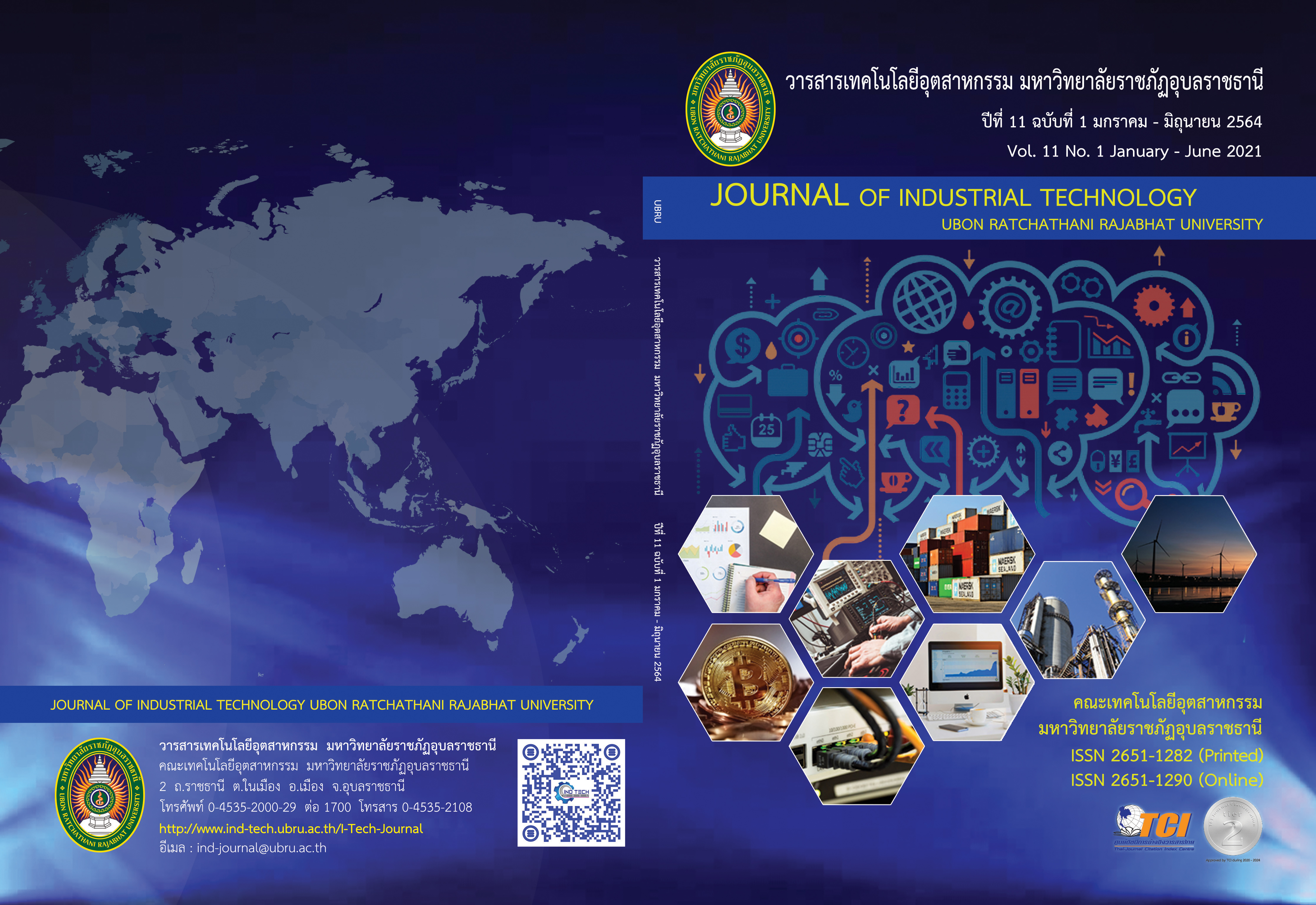การวิเคราะห์ปัจจัยเสี่ยงต่อการเกิดโรคไข้เลือดออก
Main Article Content
บทคัดย่อ
งานวิจัยนี้ เป็นการศึกษาปัจจัยเสี่ยงที่มีความสัมพันธ์กับการเกิดโรคไข้เลือดออก โดยนำข้อมูลจากวิทยานิพนธ์ เรื่อง การกระจายตัวของลูกน้ำยุงในประเทศไทย จำนวน 8,245 ระเบียน ประกอบด้วยข้อมูล ชนิดภาชนะ ระดับน้ำ ฝาปิด ชนิดฝาปิด สีของภาชนะ และความเสี่ยงในการเกิดโรคไข้เลือดออก ผู้วิจัยได้นำปัจจัยที่เก็บรวบรวมทั้งหมด 5 ปัจจัย มาวิเคราะห์ความเป็นไปได้ในการนำข้อมูลไปใช้ โดยพิจารณาจากความสัมพันธ์ของปัจจัยนั้น ๆ ต่อความเสี่ยงต่อการเกิดโรคไข้เลือดออก ด้วยวิธีการวิเคราะห์การถดถอย จากการวิเคราะห์ พบว่า ปัจจัยทั้ง 5 ปัจจัย ได้แก่ ชนิดของภาชนะ ระดับน้ำ ฝาปิด ชนิดฝาปิด และสีของภาชนะ มีผลต่อการเกิดโรคไข้เลือดออกอย่างมีนัยสำคัญทางสถิติ (P<0.05) จากนั้นจึงจัดกลุ่มข้อมูลโดยใช้อัลกอริทึมเคมีน เพื่อพิจารณาว่าปัจจัยใดบ้างที่อยู่ในกลุ่มเดียวกัน โดยการประมวลผลการทำงานของกลุ่ม (เค) จำนวน 100 รอบ เพื่อหากลุ่มที่ดีที่สุด ปรากฎว่าได้จำนวนกลุ่มที่ดีที่สุด 2 กลุ่ม คือ กลุ่มเสี่ยงและไม่เสี่ยง ค่าความถูกต้องของข้อมูลจากการสุ่มการทำงานของกลุ่ม จำนวน 2 กลุ่ม ให้ค่าความถูกต้องของโมเดลอยู่ที่ 66.8% ซึ่งสามารถนำไปใช้ในการหาความสัมพันธ์ต่อไปได้ จากนั้นนำกลุ่มที่ถูกจัดด้วยอัลกอริทึมเคมีนไปหาความสัมพันธ์ด้วยอัลกอริทึมแอพริโอริ ได้ค่าความเชื่อมั่นเท่ากับ 0.95 และได้จำนวนกฎทั้งหมด คือ 131 กฎ ผลลัพธ์ที่ได้จากการหาความสัมพันธ์ในแต่ละกลุ่ม คือ ไม่มีความแตกต่างกัน เช่น ถ้าใช้ถังพลาสติกที่มีฝาปิดในการบรรจุน้ำจะไม่มีความเสี่ยง หรือ ถ้าภาชนะกักเก็บน้ำเป็นสีดำและไม่มีฝาปิดจะมีความเสี่ยงในการเกิดโรคไข้เลือดออก เป็นต้น
Article Details

อนุญาตภายใต้เงื่อนไข Creative Commons Attribution-NonCommercial-NoDerivatives 4.0 International License.
บทความที่ได้รับการตีพิมพ์ในวารสารฯ ท้ังในรูปแบบของรูปเล่มและอิเล็กทรอนิกส์เป็นลิขสิทธิ์ของวารสารฯ
เอกสารอ้างอิง
Bumrungrad International Hospital. 2018. dengue hemorrhagic fever. [Online]: https://www.bum rungrad.com/th/conditions/dengue-hemorrhagic-fever (in Thai)
Bangkokbiznews 2018. Against dengue hemorrhagic fever. [Online]: http://www.bangkokbiz news.com/pr/detail/29735. (in Thai)
Sermkarndee P, Manwicha J, Khunchoo R. Risk Areas Analysis of Dengue Fever Using Geographic Information Systems, Hatyai District, Songkhla Province. Hat Yai National and International Academic Conference. 2016; (7): p. 1355-65. (in Thai)
Seuyam T. Hazards dengue fever during the rainy season. [Online]: https://www.ry t9.com/s/ iq01/2869467; 2018. (in Thai)
Office of the Health Promotion Foundation. 2561. Domicile of people with dengue fever. [Online]: http://www.thaihealth.or.th/Content/41872- ConcernedDHF.html. (in Thai)
Phipathananunth C, Jalearnrat S. Socio-Economic Household Data Analysis Using the Clustering and Association Technique for Data Mining. NIDA Development Journal. 2016; (3). (in Thai)
Nuankaew W, Nuankaew P, Budsaman S, Thanasiratham P. A Comparative Model of Cultural Tourism in the North and the Northeast of Thailand. Management Journal Information technology and innovation. 2017; (2): p. 26-38. (in Thai)
Vongpipan T. Lease Approval Using Data Mining Techniques. Department of Computer and Communication Technology Faculty of Engineering, Dhurakij Pundit University; 2013. (in Thai)
Kajornkasirat S, Chanapai N, Hnusuwan B. Smart health monitoring system with IoT. 2018 IEEE Symposium on Computer Applications & Industrial Electronics (ISCAIE). Penang, Malaysia; 2018. 206-11.
Exarchos TP, Rigas G, Bibas A, Kikidis D, Nikitas C, Wuyts FL, Ihtijarevic B, Maes L, Cenciarini M, Maurer C, Macdonald N, Bamiou DE, Luxon L, Prasinos M, Spanoudakis G, Koutsouris D, Fotiadis DI. Mining balance disorders' data for the development of diagnostic decision support systems. Computers in Biology and Medicine; 2016. 77: 240–8.
Jianguo Chen, Kenli Li, Huigui Rong, Kashif Bilal, Nan Yang, Keqin Li. A disease diagnosis and treatment recommendation system based on big data mining and cloud computing. Information Sciences; 2018. 435: 124–49.
Buathong W. Clustering: K-means. [Online]: https://wipawanblog.files.wordpress.com/2014/06/ chapter-8-clustering-K-means.pdf; 2014. (in Thai)
Ekasit Patcharawongsakda. Introduction to Data Mining and Big Data Analytics. [Online]: http://dataminingtrend.com/2014/; 2017. (in Thai)
Waewkratok C, Yangkratok S, Apinandecha C. Factors correlated to role of community leader in prevention and control Hemorrhagic fever in Pongdang Sub-District, Kham Talasor District, Kakhonratchasima. National Academic Conference and Research Presentation. 2017; (3): p. 426-34. (in Thai)
Intasri C, Sarawong P, Palitnonkert A and Eamjoy D. Factor related to dengue hemorrhagic fever prevention of people in Bankongbangna, Srisajorakeanoi, Bang Saotong district, Samutprakan province, Thailand. 2017; (3): p. 43-51. (in Thai)
Wongkoon S. Aedes larval distribution in Thailand [thesis]. Nakhon Si Thammarat: Computational Science. Walailak University; 2011.
Shehroz S.K. and Amir A. 2013. Cluster Center Initialization Algorithm for K-modes Clustering. Expert Systems with Applications. 40(18): 7444–56.
Department of Medical Sciences, Ministry of Public Health. 2562. Mosquito Biology and Ecology. [Online]: http://webdb.dmsc.moph.go.th/ifc_nih/a_nih_1_001c.asp?info_id=1366. (in Thai)
Khanthikun N, Suwannakerd W, Seajeng A, Sudathip P, Thipmontri R, Chaoprom S. Forecasting patterns of dengue fever in 8 northern provinces of Thailand. [Online]: http://irem2.ddc.moph.go.th/ researches/download/files/4803; 2012. (in Thai)
Promprao S, Ratmanee Y, Kaikaew J. Ecology of Aedes Mosquitoes in Kreang Sub-District, Cha-Uat District, Nakhon Si Thammarat. Thaksin.J. 2018; 21 (1).


